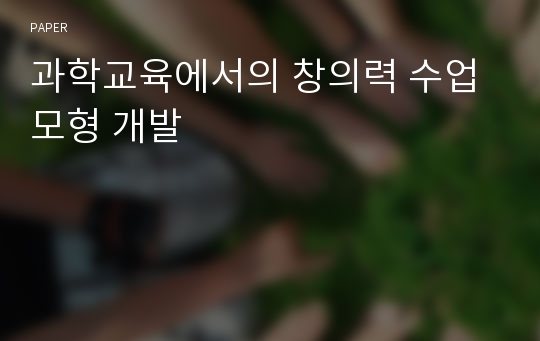* 본 문서는 배포용으로 복사 및 편집이 불가합니다.
서지정보
ㆍ발행기관 : 한국창의력교육학회
ㆍ수록지정보 : 창의력교육연구 / 3권 / 1호
ㆍ저자명 : 우종옥, 김승훈, 강심원
ㆍ저자명 : 우종옥, 김승훈, 강심원
목차
Ⅰ. 서 론Ⅱ. 이론적 배경
Ⅲ. 과학교육에서의 창의력 수업모형개발
Ⅳ. 결론 및 제언
< 참고문헌 >
한국어 초록
The purpose of this study is to develop a Creativity Instructional Model for the development of creativity in science education. The recent increased of creativity in school education, creativity is one of the top priority in the 7th national curriculum to pursue creative person based on basin abilities. The purpose of creativity education is to enhance the quality is life through the development of creative problem solving ability and creation of new knowledge. There are two different approaches in the development of creativity education program; one is subject-specific method which emphasizing process and the other is subject-free method which is specially designed creativity training program. In school practice, since learning and instruction is possible though subject matter education, the development and implementation of creativity matter is necessary. In this respect, the researcher chose subject-specific method in this research.In science education, creativity is " to basic scientific knowledge, inquiry skills, and to discover a relevant and new problem solving method to solve the confronted problem using the elements of scientific creativity. Therefore, creative problem solving ability is one of the most important in science education. For this reason, a science creativity instruction model based on the analysis and synthesis of the existing science process model and CPS model developed in this study to enhance creativity through subject matter education. The researcher designed a five creativity instruction model; Problem-Finding, Generating-Hypothesis, Solution-Finding & Performance, Solution-Synthesis, and Elaboration Although this model was designed for science subject, it could be applied to other subject areas. However, since there could be differences in the basic skills and instructional methods, to apply the model to other subject areas, it should be modified to be relevant to the targer subject area, school, students' ability, and students' characteristics. In addition to the base of creative environment, this research proposed three elements of scientific creativity; (1) subject-specific knowledge and skills, (2) creativity-relevant skills, and (3) creative motivation
Keyword: creativity, creative instruction model, creative problem solving

























